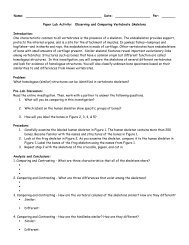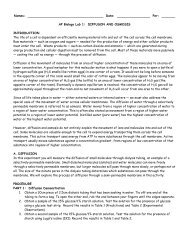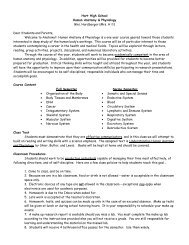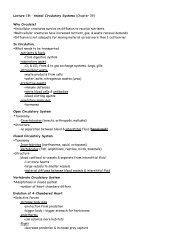Article 3 Epigenetic Influences and Disease - Hart High School
Article 3 Epigenetic Influences and Disease - Hart High School
Article 3 Epigenetic Influences and Disease - Hart High School
Create successful ePaper yourself
Turn your PDF publications into a flip-book with our unique Google optimized e-Paper software.
<strong>Epigenetic</strong> <strong>Influences</strong> <strong>and</strong> <strong>Disease</strong> | Learn Science at Scitablehttp://www.nature.com/scitable/topicpage/<strong>Epigenetic</strong>-<strong>Influences</strong>-<strong>and</strong>-<strong>Disease</strong>-895Page 1 of 911/16/2009<strong>Epigenetic</strong> <strong>Influences</strong> <strong>and</strong> <strong>Disease</strong>GENES AND DISEASE | Lead Editor: Alex<strong>and</strong>re VieiraBy: Danielle Simmons, Ph.D. (Write Science Right) © 2008 Nature EducationCitation: Simmons, D. (2008) <strong>Epigenetic</strong> influence <strong>and</strong> disease. Nature Education 1(1)The behavior of a person's genes doesn't just depend on the genes' DNAsequence--it's also affected by so-called epigenetic factors. Changes in thesefactors can play a critical role in disease.The external environment's effects upon genes can influence disease, <strong>and</strong> some of these effectscan be inherited in humans. Studies investigating how environmental factors impact the geneticsof an individual's offspring are difficult to design. However, in certain parts of the world in whichsocial systems are highly centralized, environmental information that might have influencedfamilies can be obtained. For example, Swedish scientists recently conducted investigationsexamining whether nutrition affected the death rate associated with cardiovascular disease <strong>and</strong>diabetes <strong>and</strong> whether these effects were passed from parents to their children <strong>and</strong> gr<strong>and</strong>children(Kaati et al., 2002). These researchers estimated how much access individuals had to food byexamining records of annual harvests <strong>and</strong> food prices in Sweden across three generations offamilies, starting as far back as the 1890s. These researchers found that if a father did not haveenough food available to him during a critical period in his development just before puberty, hissons were less likely to die from cardiovascular disease. Remarkably, death related to diabetesincreased for children if food was plentiful during this critical period for the paternal gr<strong>and</strong>father,but it decreased when excess food was available to the father. These findings suggest that dietcan cause changes to genes that are passed down though generations by the males in a family,<strong>and</strong> that these alterations can affect susceptibility to certain diseases. But what are thesechanges, <strong>and</strong> how are they remembered? The answers to questions such as these lie in theconcept of epigenetics.What Is <strong>Epigenetic</strong>s? How Do <strong>Epigenetic</strong> Changes Affect Genes?<strong>Epigenetic</strong>s involves genetic control by factors other than an individual's DNA sequence.<strong>Epigenetic</strong> changes can switch genes on or off <strong>and</strong> determine which proteins are transcribed.<strong>Epigenetic</strong>s is involved in many normal cellular processes. Consider the fact that our cells allhave the same DNA, but our bodies contain many different types of cells: neurons, liver cells,pancreatic cells, inflammatory cells, <strong>and</strong> others. How can this be? In short, cells, tissues, <strong>and</strong>organs differ because they have certain sets of genes that are "turned on" or expressed, as well
<strong>Epigenetic</strong> <strong>Influences</strong> <strong>and</strong> <strong>Disease</strong> | Learn Science at Scitablehttp://www.nature.com/scitable/topicpage/<strong>Epigenetic</strong>-<strong>Influences</strong>-<strong>and</strong>-<strong>Disease</strong>-895Page 2 of 911/16/2009as other sets that are "turned off" orinhibited. <strong>Epigenetic</strong> silencing is one wayto turn genes off, <strong>and</strong> it can contribute todifferential expression. Silencing mightalso explain, in part, why genetic twinsare not phenotypically identical. Inaddition, epigenetics is important for X-chromosome inactivation in femalemammals, which is necessary so thatfemales do not have twice the number ofX-chromosome gene products as males(Egger et al., 2004). Thus, thesignificance of turning genes off viaepigenetic changes is readily apparent.The genetic material; theFigure 1: Interaction between RNA, histonebiochemical that forms genes.modification <strong>and</strong> DNA methylation in heritablegene silencing.Within cells, there are three systems that © 2004, Nature Publishing Group, Egger, G.,can interact with each other to silence <strong>Epigenetic</strong>s in human disease <strong>and</strong> prospectsgenes: DNA methylation, histonefor epigenetic therapy, Nature 429, Explore 457-463 this Furthermodifications, <strong>and</strong> RNA-associated silencing (Figure 1; Egger et al., 2004).DNA MethylationDNA methylation is a chemical process that adds a methyl group to DNA. It is highly specific <strong>and</strong>always happens in a region in which a cytosine nucleotide is located next to a guanine nucleotidethat is linked by a phosphate; this is called a CpG site (Egger et al., 2004; Jones & Baylin, 2002;Robertson, 2002). CpG sites are methylated by one of three enzymes called DNAmethyltransferases (DNMTs) (Egger et al., 2004; Robertson, 2002). Inserting methyl groupschanges the appearance <strong>and</strong> structure of DNA, modifying a gene's interactions with themachinery within a cell's nucleus that is needed for transcription. DNA methylation is used insome genes to differentiate which gene copy is inherited from the father <strong>and</strong> which gene copy isinherited from the mother, a phenomenon known as imprinting.Histone ModificationsHistones are proteins that are the primary components of chromatin, which is the complex ofDNA <strong>and</strong> proteins that makes up chromosomes. Histones act as a spool around which DNA canwind. When histones are modified after they are translated into protein (i.e., post-translationmodification), they can influence how chromatin is arranged, which, in turn, can determinewhether the associated chromosomal DNA will be transcribed. If chromatin is not in a compactform, it is active, <strong>and</strong> the associated DNA can be transcribed. Conversely, if chromatin iscondensed (creating a complex called heterochromatin), then it is inactive, <strong>and</strong> DNA transcriptiondoes not occur.There are two main ways histones can be modified: acetylation <strong>and</strong> methylation. These arechemical processes that add either an acetyl or methyl group, respectively, to the amino acidlysine that is located in the histone. Acetylation is usually associated with active chromatin, whiledeacetylation is generally associated with heterochromatin. On the other h<strong>and</strong>, histonemethylation can be a marker for both active <strong>and</strong> inactive regions of chromatin. For example,DNA
<strong>Epigenetic</strong> <strong>Influences</strong> <strong>and</strong> <strong>Disease</strong> | Learn Science at Scitablehttp://www.nature.com/scitable/topicpage/<strong>Epigenetic</strong>-<strong>Influences</strong>-<strong>and</strong>-<strong>Disease</strong>-895Page 3 of 911/16/2009methylation of a particular lysine (K9) on a specific histone (H3) that marks silent DNA is widelydistributed throughout heterochromatin. This is the type of epigenetic change that is responsiblefor the inactivated X chromosome of females. In contrast, methylation of a different lysine (K4) onthe same histone (H3) is a marker for active genes (Egger et al., 2004).RNA-Associated SilencingGenes can also be turned off by RNA when it is in the form of antisense transcripts, noncodingRNAs, or RNA interference. RNA might affect gene expression by causing heterochromatin toform, or by triggering histone modifications <strong>and</strong> DNA methylation (Egger et al., 2004).<strong>Epigenetic</strong>s <strong>and</strong> <strong>Disease</strong>: Some ExamplesWhile epigenetic changes are required for normal development <strong>and</strong> health, they can also beresponsible for some disease states. Disrupting any of the three systems that contribute toepigenetic alterations can cause abnormal activation or silencing of genes. Such disruptionshave been associated with cancer, syndromes involving chromosomal instabilities, <strong>and</strong> mentalretardation (Table 1).Table 1: <strong>Epigenetic</strong> diseases: Causes <strong>and</strong> symptoms.Copyright 2004 Nature Publishing Group, Egger, G., <strong>Epigenetic</strong>s in human disease <strong>and</strong> prospectsfor epigenetic therapy, Nature 429, 457-463<strong>Epigenetic</strong>s <strong>and</strong> CancerThe first human disease to be linked to epigenetics was cancer, in 1983. Researchers found thatdiseased tissue from patients with colorectal cancer had less DNA methylation than normaltissue from the same patients (Feinberg & Vogelstein, 1983). Because methylated genes aretypically turned off, loss of DNA methylation can cause abnormally high gene activation byaltering the arrangement of chromatin. On the other h<strong>and</strong>, too much methylation can undo thework of protective tumor suppressor genes.As previously mentioned, DNA methylation occurs at CpG sites, <strong>and</strong> a majority of CpG cytosinesare methylated in mammals. However, there are stretches of DNA near promoter regions that
<strong>Epigenetic</strong> <strong>Influences</strong> <strong>and</strong> <strong>Disease</strong> | Learn Science at Scitablehttp://www.nature.com/scitable/topicpage/<strong>Epigenetic</strong>-<strong>Influences</strong>-<strong>and</strong>-<strong>Disease</strong>-895Page 4 of 911/16/2009have higher concentrations of CpG sites (known as CpG isl<strong>and</strong>s) that are free of methylation innormal cells. These CpG isl<strong>and</strong>s become excessively methylated in cancer cells, therebycausing genes that should not be silenced to turn off. This abnormality is the trademarkepigenetic change that occurs in tumors <strong>and</strong> happens early in the development of cancer (Eggeret al., 2004; Robertson, 2002; Jones & Baylin, 2002). Hypermethylation of CpG isl<strong>and</strong>s cancause tumors by shutting off tumor-suppressor genes. In fact, these types of changes may bemore common in human cancer than DNA sequence mutations (Figure 2).Furthermore, although epigenetic changes do not alter the sequence of DNA, they can causemutations. About half of the genes that cause familial or inherited forms of cancer are turned offby methylation. Most of these genes normally suppress tumor formation <strong>and</strong> help repair DNA,including O6-methylguanine-DNA methyltransferase (MGMT), MLH1 cyclin-dependent kinaseinhibitor 2B (CDKN2B), <strong>and</strong> RASSF1A. For example, hypermethylation of the promoter of MGMTcauses the number of G-to-A mutations to increase (Figure 2).Hypermethylation can also lead to instability of microsatellites, which are repeated sequences ofDNA. Microsatellites are common in normal individuals, <strong>and</strong> they usually consist of repeats of thedinucleotide CA. Too much methylation of the promoter of the DNA repair gene MLH1 can makea microsatellite unstable <strong>and</strong> lengthen or shorten it (Figure 2). Microsatellite instability has beenlinked to many cancers, including colorectal, endometrial, ovarian, <strong>and</strong> gastric cancers (Jones &Baylin, 2002).
<strong>Epigenetic</strong> <strong>Influences</strong> <strong>and</strong> <strong>Disease</strong> | Learn Science at Scitablehttp://www.nature.com/scitable/topicpage/<strong>Epigenetic</strong>-<strong>Influences</strong>-<strong>and</strong>-<strong>Disease</strong>-895Page 5 of 911/16/2009Figure 2: Mechanism of action of nucleoside analogue inhibitors.Deoxynucleoside analogues such as 5-aza-2-deoxycytidine (depicted by Z) are converted into thetriphosphate inside S-phase cells <strong>and</strong> are incorporated in place of cytosine into DNA. Ribonucleosides suchas 5-azacytidine or zebularine are reduced at the diphosphate level by ribonucleotide reductase forincorporation (not shown). Once in DNA, the fraudulent bases form covalent bonds with DNAmethyltransferases (DNMTs), resulting in the depletion of active enzymes <strong>and</strong> the demethylation of DNA.Pink circles, methylated CpG; cream circles, unmethylated CpG.© 2002, Nature Publishing Group, Jones, P. A., et. al., The fundamental role of epigenetic events incancer, Nature Reviews Genetics 3, 415-428<strong>Epigenetic</strong>s <strong>and</strong> Mental RetardationFragile X syndrome is the mostfrequently inherited mental disability,particularly in males. Both sexes can beaffected by this condition, but becausemales only have one X chromosome,one fragile X will impact them moreseverely. Indeed, fragile X syndromeoccurs in approximately 1 in 4,000 males<strong>and</strong> 1 in 8,000 females. People with thissyndrome have severe intellectualdisabilities, delayed verbal development,<strong>and</strong> "autistic-like" behavior(Penagarikano et al., 2007).Fragile X syndrome gets its name fromthe way the part of the X chromosomethat contains the gene abnormality looksunder a microscope; it usually appearsas if it is hanging by a thread <strong>and</strong> easilybreakable (Figure 3). The syndrome iscaused by an abnormality in the FMR1(fragile X mental retardation 1) gene.People who do not have fragile Xsyndrome have 6 to 50 repeats of thetrinucleotide CGG in their FMR1 gene.However, individuals with over 200repeats have a full mutation, <strong>and</strong> theyusually show symptoms of theFigure 3: The marker X chromosome.Metaphase chromosomes showing the peculiarconstriction at the end of the long arm ofchromosome X that is characteristic in fragile X(FX) individuals. The black arrowhead marks themarker X chromosome in the upper right h<strong>and</strong>quadrant.Copyright 2007 Annual Reviews, Thepathophysiology of fragile X syndrome, byPenagarikano, O., et. al., Annual Review ofGenomics <strong>and</strong> Human Genetics 8, 109-129syndrome. Too many CGGs cause the CpG isl<strong>and</strong>s at the promoter region of the FMR1 gene tobecome methylated; normally, they are not. This methylation turns the gene off, stopping theFMR1 gene from producing an important protein called fragile X mental retardation protein. Lossof this specific protein causes fragile X syndrome. Although a lot of attention has been given tothe CGG expansion mutation as the cause of fragile X, the epigenetic change associated withFMR1 methylation is the real syndrome culprit.
<strong>Epigenetic</strong> <strong>Influences</strong> <strong>and</strong> <strong>Disease</strong> | Learn Science at Scitablehttp://www.nature.com/scitable/topicpage/<strong>Epigenetic</strong>-<strong>Influences</strong>-<strong>and</strong>-<strong>Disease</strong>-895Page 6 of 911/16/2009Fragile X syndrome is not the only disorder associated with mental retardation that involvesepigenetic changes. Other such conditions include Rubenstein-Taybi, Coffin-Lowry, Prader-Willi,Angelman, Beckwith-Wiedemann, ATR-X, <strong>and</strong> Rett syndromes (Table 1).Combating <strong>Disease</strong>s with <strong>Epigenetic</strong> TherapyBecause so many diseases, such as cancer, involve epigenetic changes, it seemsreasonable to try to counteract these modifications with epigenetic treatments. These changesseem an ideal target because they are by nature reversible, unlike DNA sequence mutations.The most popular of these treatments aim to alter either DNA methylation or histone acetylation.Inhibitors of DNA methylation can reactivate genes that have been silenced. Two examples ofthese types of drugs are 5-azacytidine <strong>and</strong> 5-aza-2′-deoxycytidine (Egger et al., 2004). Thesemedications work by acting like the nucleotide cytosine <strong>and</strong> incorporating themselves into DNAwhile it is replicating. After they are incorporated into DNA, the drugs block DNMT enzymes fromacting, which inhibits DNA methylation.Drugs aimed at histone modifications are called histone deacetylase (HDAC) inhibitors. HDACsare enzymes that remove the acetyl groups from DNA, which condenses chromatin <strong>and</strong> stopstranscription. Blocking this process with HDAC inhibitors turns on gene expression. The mostcommon HDAC inhibitors include phenylbutyric acid, SAHA, depsipeptide, <strong>and</strong> valproic acid(Egger et al., 2004).Caution in using epigenetic therapy is necessary because epigenetic processes <strong>and</strong> changes areso widespread. To be successful, epigenetic treatments must be selective to irregular cells;otherwise, activating gene transcription in normal cells could make them cancerous, so thetreatments could cause the very disorders they are trying to counteract. Despite this possibledrawback, researchers are finding ways to specifically target abnormal cells with minimaldamage to normal cells, <strong>and</strong> epigenetic therapy is beginning to look increasingly promising.References <strong>and</strong> Recommended ReadingEgger, G., et al. <strong>Epigenetic</strong>s in human disease <strong>and</strong> prospects for epigenetic therapy. Nature 429,457–463 (2004) doi:10.1038/nature02625 (link to article)Feinberg, A.P., & Vogelstein, B. Hypomethylation distinguishes genes of some human cancersfrom their normal counterparts. Nature 301, 89–92 (1983) doi:10.1038/301089a0 (link to article)Jones, P. A., & Baylin, S. B. The fundamental role of epigenetic events in cancer. NatureReviews Genetics 3, 415–428 (2002) doi:10.1038/nrg816 (link to article)Kaati, G., et al. Cardiovascular <strong>and</strong> diabetes mortality determined by nutrition during parents' <strong>and</strong>gr<strong>and</strong>parents' slow growth period. European Journal of Human Genetics 10, 682–688 (2002)Penagarikano, O., et al. The pathophysiology of fragile X syndrome. Annual Review of Genomics<strong>and</strong> Human Genetics 8, 109–129 (2007) doi:10.1146/annurev.genom.8.080706.092249
<strong>Epigenetic</strong> <strong>Influences</strong> <strong>and</strong> <strong>Disease</strong> | Learn Science at Scitablehttp://www.nature.com/scitable/topicpage/<strong>Epigenetic</strong>-<strong>Influences</strong>-<strong>and</strong>-<strong>Disease</strong>-895Page 7 of 911/16/2009Robertson, K. D. DNA methylation <strong>and</strong> chromatin: Unraveling the tangled web. Oncogene 21,5361–5379 (2002) doi:10.1038/sj.onc.1205609This reading is linked to the following Scitable pages:
<strong>Epigenetic</strong> <strong>Influences</strong> <strong>and</strong> <strong>Disease</strong> | Learn Science at ScitablePage 8 of 9Imprinting <strong>and</strong> Genetic <strong>Disease</strong>: Angelman, Prader-Willi, <strong>and</strong> Beckwith-WiedemannSyndromesWe each get two copies of every gene--one copy from each of our parents. But whathappens when one of these genes has been "turned off", or imprinted, <strong>and</strong> the remaininggene is defective?The Role of Methylation in Gene ExpressionNot all genes are active at all times. DNA methylation is one of several epigeneticmechanisms that cells use to control gene expression.Epigenomics: The New Tool in Studying Complex <strong>Disease</strong>sIdentical twins often develop different characteristics, even though they carry the samesequence of DNA nucleotides. How can this be? The answer lies in epigenomics.Gene Expression Regulates Cell DifferentiationHow is it that your body with all of its specialized organs developed from a single cell?Scientists are exploring how gene expression patterns <strong>and</strong> their timing regulate celldifferentiation.DNA Sequencing TechnologiesThe Human Genome project set out to sequence all of the 3 billion nucleotides in thehuman genome. Exactly how was this daunting task done with such incredible speed <strong>and</strong>accuracy?Chromosome Segregation in Mitosis: The Role of CentromeresWithout centromeres, cells cannot divide properly <strong>and</strong> the overall process of mitosis fails.Why are these small chromosomal regions so essential to such a major cellular process?Genes <strong>and</strong> <strong>Disease</strong> Topic RoomGenes <strong>and</strong> <strong>Disease</strong> Topic Room. Lead Editor: Alex<strong>and</strong>re Vieira, Ph.D.Comparative Methylation HybridizationHow do complex adult-onset disorders take place? The methylation of DNA sequences isan important component of epigenetic control that can be inherited or occur over time.http://www.nature.com/scitable/topicpage/<strong>Epigenetic</strong>-<strong>Influences</strong>-<strong>and</strong>-<strong>Disease</strong>-89511/16/2009
<strong>Epigenetic</strong> <strong>Influences</strong> <strong>and</strong> <strong>Disease</strong> | Learn Science at Scitablehttp://www.nature.com/scitable/topicpage/<strong>Epigenetic</strong>-<strong>Influences</strong>-<strong>and</strong>-<strong>Disease</strong>-895Page 9 of 911/16/2009
















